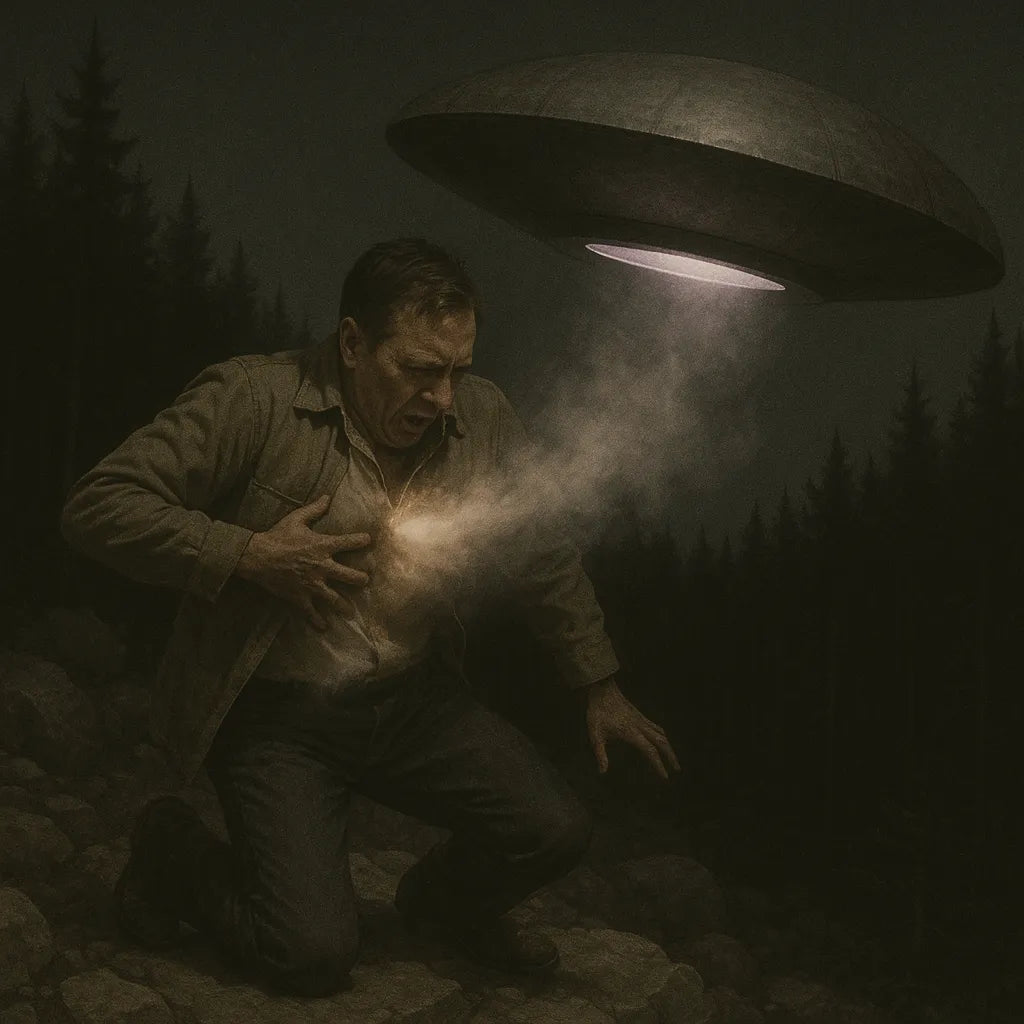
The Falcon Lake Incident: Canada’s UFO in the Pines
Share
A Prospector Alone
On May 20, 1967, Stefan “Steve” Michalak set off into the pines near Falcon Lake, Manitoba, with his rock hammer and lunch. He was fifty-one, an industrial mechanic by trade, an amateur rockhound by obsession.
By evening he was staggering into Winnipeg, pale and burned, telling a story that RCMP officers typed up the way they always did: flat, official, and unsettling.
What He Told Them
When Corporal J. Davis and Constable R. Gillis interviewed him on May 23, the report read:
“He was very uncomfortable, in considerable pain. The burn was in an area approximately 1 foot in diameter on his upper chest. It resembled an exceptionally severe sunburn in the one spot.”
Michalak told them he had been prospecting when two glowing, cigar-shaped objects appeared, one landing on a rock outcrop. He heard a whistling sound, saw an opening, and thought he heard voices.
“If you are Yankee boys, come out and don’t be afraid,” he recalled saying, trying English, Polish, German, Russian.
No reply. Just a violet light from inside.
When the object rotated, hot gas vented through a grid.
“That very moment, it got my shirt.”
 The Aftermath in His Words
The Aftermath in His Words
On May 24, RCMP recorded a continuation interview:
“He stated that he immediately became nauseated and began to vomit. He staggered from the clearing, noting a smell of burning electrical insulation. He stated the odor remained with him until late in the evening.”
His son remembered that night: the smell clung to him, “like sulfur and burnt wires.” He spent the night vomiting, his skin blistering in squares.
 The Burnt Rock and the Radiation Question
The Burnt Rock and the Radiation Question
Weeks later, investigators followed him back to the site. The moss on the rock was scorched away in a semicircle. Geiger counters ticked higher than background. Soil scraped from a crack was bagged as evidence.
A later Department of National Defence memo stated simply:
“Samples were found to be radioactive. The origin is undetermined. Both DND and RCMP investigation teams were unable to provide evidence which would dispute Mr. Michalak’s story.”
Not confirmation. Not denial. Just bureaucracy admitting it had hit a wall.
 Folklore in the North Woods
Folklore in the North Woods
Take away the lab reports and it sounds older than 1967. A man alone in the pines. A fiery craft descending in the wilderness. A blast that leaves his chest seared and his clothes ruined.
Indigenous Manitoban traditions speak of sky beings and spirits of fire. Across cultures, lakes are liminal places, thresholds to other realms. Falcon Lake becomes not just a UFO case but a Canadian myth of contact—a man burned by something from the sky.
 Legacy in Metal and Memory
Legacy in Metal and Memory
The story never went away. UFO writers call it Canada’s Roswell. Skeptics file it under “possible hoax, unproven.” His son, Stan, remembers it differently:
“He looked pale, haggard. If Dad hoaxed this, then he was a freakin’ genius. But he wasn’t. He never wanted the attention, and he never changed his story.”
In 2018, the Royal Canadian Mint struck a silver coin that glows in the dark, marking Falcon Lake as part of Canadian heritage.
A prospector went looking for silver and came back with burns—and a legend.
Conclusion
The Falcon Lake Incident sits in a strange place: part UFO case file, part folklore, part cultural artifact. The RCMP reports are stiff, factual, but they don’t erase the image: a man on his knees in the pines, coughing sulfur, chest seared in a checkerboard, whispering to himself that he’d only wanted to find rock.
It’s the kind of story Canada doesn’t usually tell—but one that refuses to fade.
At Falcon Lake the sky left burns on a single chest. At Ariel School, it left warnings on dozens of young minds. Follow into The Ariel School Encounter — and uncover the Out of This World Collection, artifacts that echo every encounter, from solitary to shared.